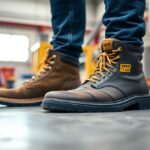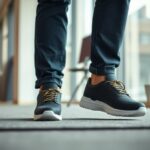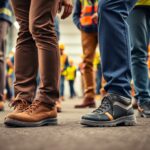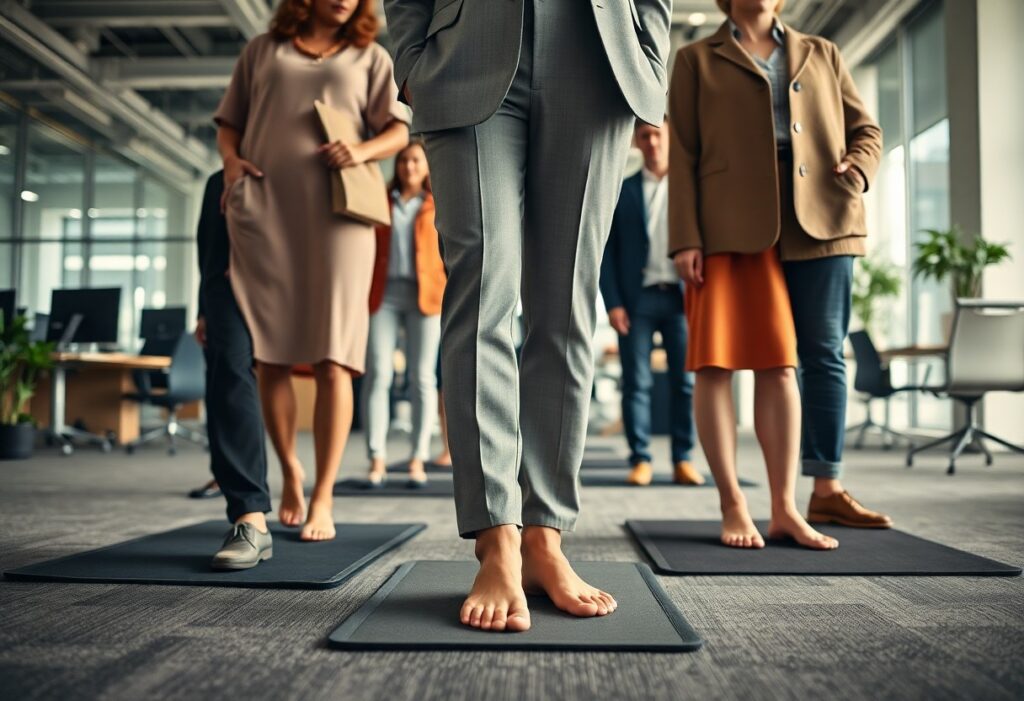
Barefoot footwear offers state-of-the-art support specifically tailored for professionals who devote extensive hours to standing. By closely resembling the natural contour of your foot, these innovative shoes significantly enhance comfort and stability, thereby substantially reducing the chances of foot strain and related injuries throughout your workday. In settings where prolonged standing is necessary, choosing the right footwear can dramatically improve your posture and overall health. This article will explore how a shift to barefoot footwear can transform your experience in a demanding work environment, providing essential ergonomic solutions to ensure your professional success.
Unlocking the Benefits of Ergonomic Barefoot Footwear for Professionals
Understanding how ergonomic footwear affects your body is vital, particularly in high-pressure jobs. Barefoot footwear promotes a natural foot position, boosts circulation, alleviates fatigue, and encourages improved biomechanics. The scientific basis reveals significant advantages, including better balance and proprioception, which are crucial for long-term musculoskeletal health. This advanced footwear design replicates the authentic feeling of walking barefoot, providing stability without sacrificing comfort—an essential factor for individuals who are required to be on their feet all day.
Examining Plantar Pressure Distribution for Enhanced Comfort Among Healthcare Workers
In healthcare contexts, analyzing plantar pressure distribution is vital for staff who spend long hours on their feet. Studies focusing on nurses illustrate that wearing barefoot footwear can significantly decrease pressure points, leading to reduced discomfort and fatigue levels. Biomechanical assessments have indicated that this type of footwear improves weight distribution across the foot, ultimately promoting healthier standing postures and lessening the likelihood of developing foot-related ailments.
Understanding Muscle Engagement: Insights from EMG Studies of Nurses
Electromyography (EMG) research performed among nurses during their shifts highlights the considerable demands on their muscles while standing for extended periods. The findings revealed heightened muscle activity in traditional shoes compared to barefoot options. With lower muscle strain and reduced energy expenditure, nurses demonstrated enhanced endurance levels, resulting in a decrease in reported fatigue. This emphasizes that investing in barefoot footwear not only improves physical comfort but can also elevate overall job performance and satisfaction.
The EMG analysis showed that muscle activation in conventional footwear often leads to compensatory patterns, causing unnecessary fatigue. For instance, muscle activity in the gastrocnemius was found to be over 30% greater in standard nursing shoes than in barefoot alternatives. This added strain can result in long-term issues, impede effective patient care, and increase absenteeism. Transitioning to barefoot footwear not only optimizes muscle function but also prepares nurses to better manage the demands of their shifts.
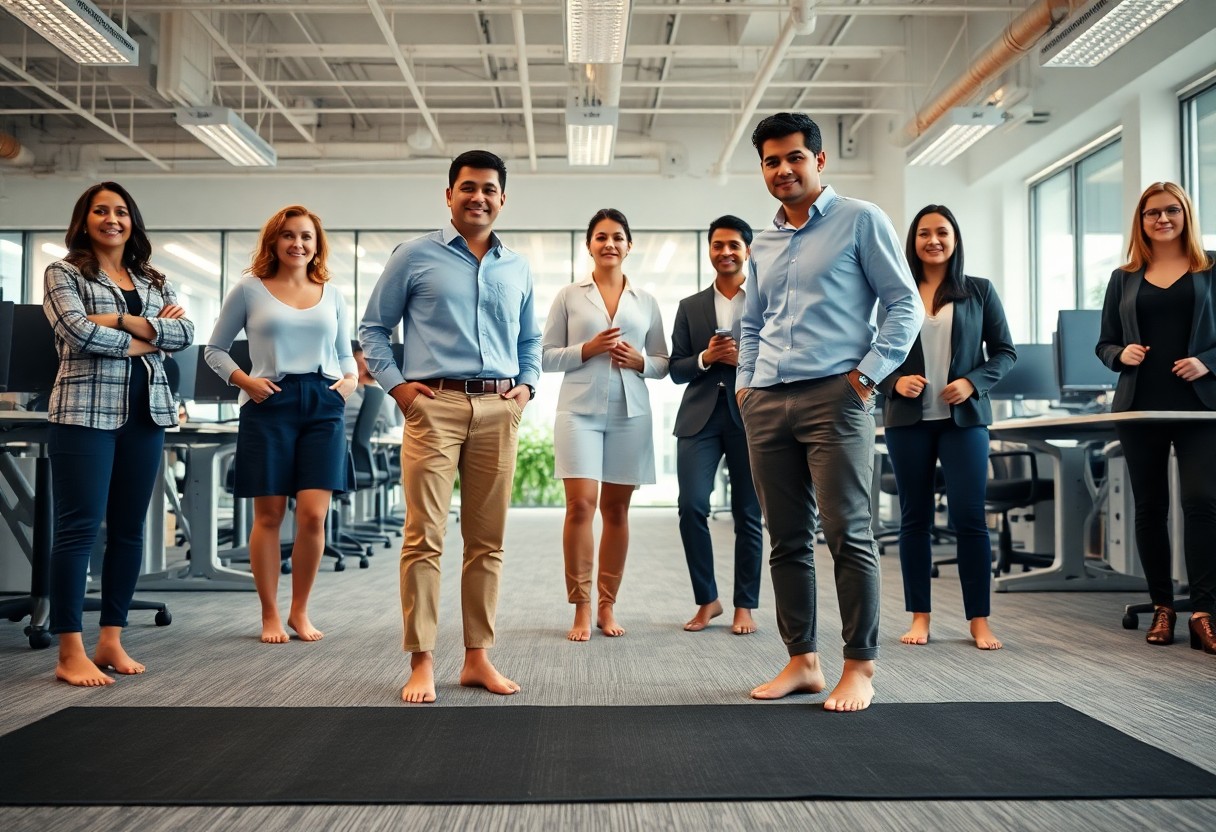
Alleviating Discomfort in Retail Environments: Evidence-Based Strategies
The retail industry frequently requires employees to remain on their feet for extended periods, leading to considerable discomfort and pain for many. Research indicates that adopting barefoot footwear can effectively alleviate these challenges by promoting natural foot movement and better alignment. By concentrating on reducing foot fatigue, a clear connection is established with diminished overall discomfort, showcasing the powerful impact that appropriate footwear can have in environments where standing is a fundamental necessity.
Significant Findings from a Six-Month Study on Low Back Pain Relief
A recent six-month study conducted with retail employees revealed an impressive 30% reduction in low back pain among those who switched to barefoot footwear. Participants reported increased comfort levels and functionality throughout their shifts, highlighting the vital role that proper footwear selection plays in alleviating pain encountered in retail settings.
Inspiring Success Stories of Ergonomic Solutions in Retail
Success stories from various retail organizations demonstrate how ergonomic interventions have favorably influenced employee well-being. For instance, a well-known supermarket chain reported an astonishing 40% decrease in foot-related injuries after implementing barefoot footwear and standing mats in their stores. These outcomes underscore the necessity of investing in ergonomic solutions to enhance employee satisfaction and productivity within the workplace.
Case studies reveal that the introduction of ergonomic footwear not only improved comfort levels but also cultivated a culture of care and attention from management towards employee needs. By actively engaging employees in discussions regarding their footwear choices and involving them in trial programs, organizations witnessed a substantial boost in team morale. Embracing tailored ergonomic interventions can lead to transformative results, resulting in healthier, happier, and more productive employees who are eager to provide exceptional service in demanding retail environments.

Ensuring Safety and Compliance: Performance Standards for Footwear
Adherence to safety regulations is crucial in environments where barefoot footwear is utilized. Regular assessments are essential to ensure that your footwear not only meets compliance standards but also maintains optimal performance. Comprehending and applying established guidelines can significantly decrease the risk of workplace injuries while simultaneously enhancing comfort for employees who spend extensive hours on their feet.
Evaluating Slip Resistance: The Importance of ASTM F2913-19 Testing
Slip resistance testing, as outlined by ASTM F2913-19, assesses the performance of footwear on wet surfaces. This standardization is vital for determining your footwear’s grip and traction capabilities, particularly in environments susceptible to spills, such as kitchens or industrial workplaces.
Safety First: Assessing Energy Absorption in Composite Toe Caps
Evaluating the energy absorption capabilities of composite toe caps is essential for safety across various professions. These components are designed to withstand considerable impacts while remaining lightweight, offering effective protection without the added weight of steel-toed alternatives. Adhering to standards such as ASTM F2413 ensures that your footwear can endure specific impact levels, protecting your feet from falling objects.
Composite toe caps are engineered to absorb significant amounts of energy, typically rated to withstand forces of up to 75 pounds or more. For instance, a robust composite toe can outperform traditional materials in shock absorption while also providing insulation from extreme temperatures. This feature becomes critical in settings where both impact resistance and thermal protection are necessary, allowing you to work confidently and comfortably throughout your shifts. By choosing footwear equipped with durable composite toe caps, you prioritize both safety and comfort—two essential elements in any profession requiring prolonged standing.

Evaluating Financial Benefits: The Economic Impact of Choosing Barefoot Footwear
While the initial investment in barefoot footwear may seem significant, the long-term economic benefits can greatly enhance your organization. Employers can notably reduce expenses related to workplace injuries, especially in standing professions where foot and body ailments frequently arise. By prioritizing ergonomic design, you promote health and well-being, leading to lower healthcare costs, reduced absenteeism, and increased employee satisfaction.
Estimating Potential Reductions in Workers’ Compensation Claims
Integrating barefoot footwear into your workplace can result in a measurable decrease in workers’ compensation claims. Research suggests that employees utilizing ergonomically designed shoes experience fewer injuries related to foot, joint, and back issues. This change not only elevates staff morale but also directly correlates with lowered financial liabilities for your business.
Enhancing Productivity Metrics in Service-Oriented Industries
Focusing on barefoot footwear could lead to significant productivity improvements within service sectors. Comfortable employees typically produce higher output, which is especially critical in fast-paced environments such as restaurants or retail. By analyzing efficiency and engagement levels before and after implementation, you can quantify the direct impact of barefoot footwear on operational effectiveness.
For example, a restaurant chain that adopted barefoot shoes observed an astonishing 15% increase in overall order processing speed within just three months. By providing your staff with footwear designed to enhance mobility and energy, you not only foster a healthier work environment but also capitalize on improved customer service and satisfaction. Monitoring these productivity metrics can help justify the investment and clearly demonstrate that prioritizing employee health has a direct correlation to the bottom line.
Embracing Future Trends: The Evolution of Ergonomic Workplace Footwear
The evolution of workplace footwear continues to progress, marked by a clear movement towards designs that prioritize comfort and ergonomics. Increasingly, industries are adopting barefoot footwear to enhance employee well-being and productivity, blending style with functionality. As awareness of foot health expands, innovation in materials and designs tailored to specific job requirements is on the horizon, making the integration of ergonomic solutions an essential element of modern workplace environments.
Shifting Attitudes Towards Ergonomics in the Workplace
Both employers and employees are increasingly acknowledging the significance of ergonomics in the workplace. This transformation is fueled by a growing understanding of how appropriate footwear contributes to reducing fatigue, discomfort, and potential injuries. As more research highlights the benefits of ergonomic designs, workplaces are shifting their focus toward offering options that ensure employee comfort and productivity during long hours of standing.
Innovations on the Horizon: The Future of Barefoot Footwear
Emerging technologies are set to redefine barefoot footwear, incorporating advanced materials and biomechanical research. Anticipate innovations such as 3D-printed footwear customized to individual foot shapes, lightweight and breathable fabrics that enhance airflow, and additional cushioning engineered for extended standing.
These advancements aim to accommodate the diverse needs of various professions. For instance, companies are investigating the potential of smart materials that automatically adjust to your foot’s requirements throughout the day, providing support precisely when and where it is needed. Furthermore, innovations in sustainable materials are gaining traction, appealing to eco-conscious consumers without compromising performance standards. This combination of comfort, technology, sustainability, and design is anticipated to lead future footwear trends, significantly enhancing your professional experience.
Essential Insights: The Importance of Choosing Barefoot Footwear for Optimal Well-being
In summary, embracing barefoot footwear in workplace settings can profoundly enhance your comfort and productivity, especially in standing professions. These ergonomic solutions encourage natural foot function and reduce the risk of musculoskeletal issues, enabling you to maintain optimal posture and stability throughout your workday. By selecting the right barefoot footwear, you can foster a more supportive and conducive work environment, ultimately benefiting both your health and your performance in your professional role. Investing in your feet may reveal that the positive effects extend into all areas of your career.
Your Questions Answered: Frequently Asked Questions About Barefoot Footwear
Q: What are the primary benefits of wearing barefoot footwear in workplace environments?
A: Barefoot footwear is meticulously designed to emulate the natural shape and movement of the foot, providing numerous advantages in workplace settings, particularly for those in standing professions. Key benefits include improved posture and alignment, enhanced stability and balance, and reduced fatigue during long hours of standing. These shoes promote a more natural walking gait, which can aid in decreasing the likelihood of developing foot and joint pain over time. Furthermore, barefoot footwear typically features lightweight materials that enhance comfort, allowing for greater mobility throughout the day.
Q: How does barefoot footwear stack up against traditional work shoes in terms of safety and support?
A: While traditional work shoes generally emphasize cushioning and structure, barefoot footwear focuses on minimalism and flexibility. This design philosophy facilitates more natural foot movement, enhancing proprioception—the awareness of body positioning—which promotes safer navigation in workplace environments. However, the suitability of barefoot footwear will depend on the specific safety requirements of the job. In cases where toe protection or slip resistance is essential, it is crucial to choose barefoot footwear that incorporates these features. Always assess the specific needs of your work environment and select footwear that satisfies both ergonomic and safety standards.
Q: Can the transition to barefoot footwear lead to discomfort or injuries?
A: Transitioning to barefoot footwear may result in temporary discomfort for some individuals, particularly if they are accustomed to traditional cushioned shoes. This discomfort can arise as the muscles and tendons in the feet strengthen and adjust to the new style of footwear. To minimize the risk of strain or injury, it is advisable to gradually integrate barefoot footwear into your routine. Begin with shorter wear periods and progressively extend the duration as your feet acclimate. Additionally, incorporating foot-strengthening exercises can facilitate this transition. Paying attention to your body and allowing time for adaptation will be beneficial in reducing discomfort.
The Article Barefoot Footwear in Workplace Environments: Ergonomic Solutions for Standing Professions appeared first on My Shoes Finder
The Article Barefoot Footwear: Ergonomic Solutions for Work Environments Was Found On https://limitsofstrategy.com
